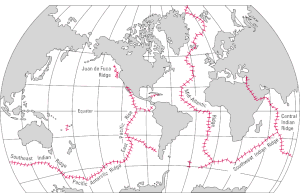Mountain range

A mountain range (mountain chain, mountain belt) is a geographic area with many mountains. A 'mountain system' or 'system of mountain ranges' includes geological features that are in the same region as a mountain range.
Mountain ranges usually include highlands or mountain passes and valleys. Individual mountains in the same range do not always have the same geology or petrology. They may be a mix of different orogenic expressions and terrains, for example thrust sheets, uplifted blocks, fold mountains, and volcanic landforms. This results in a variety of rock types.
Major ranges[change | change source]
Most geologically young mountain ranges on the Earth's land surface are associated with either in the Pacific Ring of Fire or the Alpide Belt. The Pacific Ring of Fire includes the Andes of South America, extends through the North American Cordillera along the Pacific Coast, the Aleutian Range, on through Kamchatka, Japan, Taiwan, the Philippines, Papua New Guinea, to New Zealand.[1] The Andes is 7,000 kilometres (4,350 mi) long and is often described as the world's longest mountain system.[2]
The Alpide belt includes Indonesia and southeast Asia, through the Himalayas, and ends in the Alps.[3] The belt also includes other European and Asian mountain ranges. The Himalayas contain the highest mountains in the world, including Mount Everest, at 8,848 metres (29,029 ft) of elevation.[4]

Mountain ranges outside of these two systems include the Arctic Cordillera, the world's northernmost mountain system. If the definition of a mountain range includes underwater mountains, then the ocean ridges form the longest continuous mountain system on Earth, with a length of 65,000 kilometres (40,400 mi).[5]
Divisions and categories[change | change source]
Many mountain ranges have sub-ranges within them. It can be thought of as a parent-child relationship. For example, the Appalachian Mountains range is the parent of its own ranges, two of which are the White Mountains and the Blue Ridge Mountains. The White Mountains are a child of the Appalachians, and there are also children of the Whites, like the Sandwich Range and the Presidential Range.
Climate[change | change source]

The position of mountains influences climate, such as rain or snow. When air masses move up and over mountains, the air cools producing precipitation (rain or snow). As the air descends on the leeward side, it warms again and is drier, having been stripped of much of its moisture. Often, a rain shadow will occur on the leeward side of a range.
Erosion[change | change source]
Mountain ranges are always being eroded. Erosion is at work while the mountains are being uplifted and long after until the mountains are reduced to low hills and plains. The basins next to an eroding mountain range are filled with sediments which are buried and turned into sedimentary rock.
The early Cenozoic uplift of the Rocky Mountains of Colorado are an example. As the uplift was occurring some 10,000 feet (3,000 m) of mostly Mesozoic sedimentary strata were removed by erosion and spread as sand and clays across the Great Plains to the east.[6] This mass of rock was removed as the range was actively undergoing uplift.
References[change | change source]
- ↑ Rosenberg, Matt. "Pacific Ring of Fire". About.com. Archived from the original on 2010-12-04. Retrieved 2014-03-29.
- ↑ Thorpe, Edgar (2012). The Pearson General Knowledge Manual. Pearson Education India. p. A-36.
- ↑ Chester, Roy (2008). Furnace of creation, cradle of destruction. AMACOM Div American Mgmt Assn. p. 77. ISBN 9780814409206.
- ↑ "Nepal and China agree on Mount Everest's height". BBC. 2010.
- ↑ "The mid-ocean ridge is the longest mountain range on Earth". US National Oceanic and Atmospheric Service. 11 January 2013.
- ↑ "USGS: A guide to the geology of Rocky Mountain National Park, Colorado". Archived from the original on 2015-01-24. Retrieved 2014-03-29.